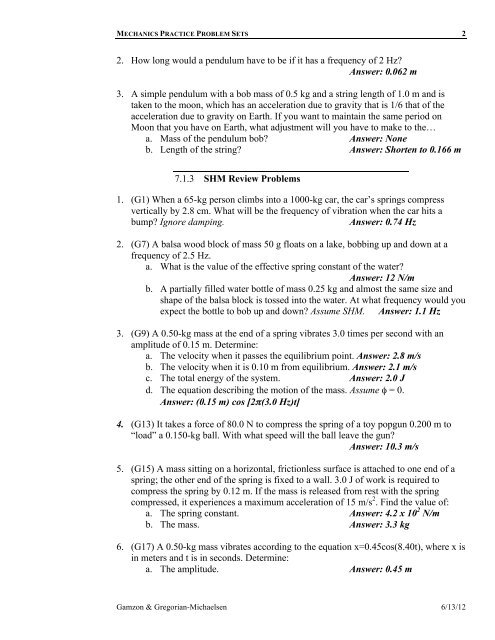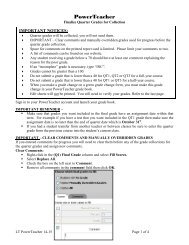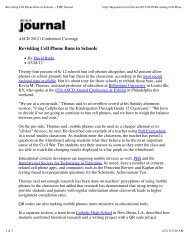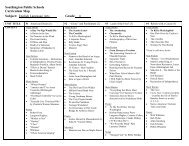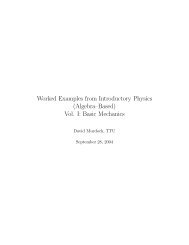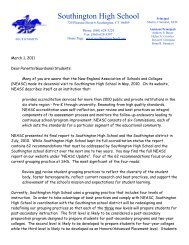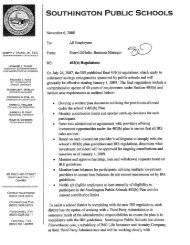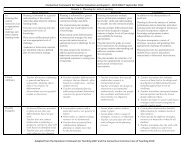SHM, Waves, Thermo, E&M Practice Problem Workbook
SHM, Waves, Thermo, E&M Practice Problem Workbook
SHM, Waves, Thermo, E&M Practice Problem Workbook
You also want an ePaper? Increase the reach of your titles
YUMPU automatically turns print PDFs into web optimized ePapers that Google loves.
MECHANICS PRACTICE PROBLEM SETS 2<br />
2. How long would a pendulum have to be if it has a frequency of 2 Hz<br />
Answer: 0.062 m<br />
3. A simple pendulum with a bob mass of 0.5 kg and a string length of 1.0 m and is<br />
taken to the moon, which has an acceleration due to gravity that is 1/6 that of the<br />
acceleration due to gravity on Earth. If you want to maintain the same period on<br />
Moon that you have on Earth, what adjustment will you have to make to the…<br />
a. Mass of the pendulum bob Answer: None<br />
b. Length of the string Answer: Shorten to 0.166 m<br />
7.1.3 <strong>SHM</strong> Review <strong>Problem</strong>s<br />
1. (G1) When a 65-kg person climbs into a 1000-kg car, the car’s springs compress<br />
vertically by 2.8 cm. What will be the frequency of vibration when the car hits a<br />
bump Ignore damping.<br />
Answer: 0.74 Hz<br />
2. (G7) A balsa wood block of mass 50 g floats on a lake, bobbing up and down at a<br />
frequency of 2.5 Hz.<br />
a. What is the value of the effective spring constant of the water<br />
Answer: 12 N/m<br />
b. A partially filled water bottle of mass 0.25 kg and almost the same size and<br />
shape of the balsa block is tossed into the water. At what frequency would you<br />
expect the bottle to bob up and down Assume <strong>SHM</strong>. Answer: 1.1 Hz<br />
3. (G9) A 0.50-kg mass at the end of a spring vibrates 3.0 times per second with an<br />
amplitude of 0.15 m. Determine:<br />
a. The velocity when it passes the equilibrium point. Answer: 2.8 m/s<br />
b. The velocity when it is 0.10 m from equilibrium. Answer: 2.1 m/s<br />
c. The total energy of the system. Answer: 2.0 J<br />
d. The equation describing the motion of the mass. Assume φ = 0.<br />
Answer: (0.15 m) cos [2π(3.0 Hz)t]<br />
4. (G13) It takes a force of 80.0 N to compress the spring of a toy popgun 0.200 m to<br />
“load” a 0.150-kg ball. With what speed will the ball leave the gun<br />
Answer: 10.3 m/s<br />
5. (G15) A mass sitting on a horizontal, frictionless surface is attached to one end of a<br />
spring; the other end of the spring is fixed to a wall. 3.0 J of work is required to<br />
compress the spring by 0.12 m. If the mass is released from rest with the spring<br />
compressed, it experiences a maximum acceleration of 15 m/s 2 . Find the value of:<br />
a. The spring constant. Answer: 4.2 x 10 2 N/m<br />
b. The mass. Answer: 3.3 kg<br />
6. (G17) A 0.50-kg mass vibrates according to the equation x=0.45cos(8.40t), where x is<br />
in meters and t is in seconds. Determine:<br />
a. The amplitude. Answer: 0.45 m<br />
Gamzon & Gregorian-Michaelsen 6/13/12


